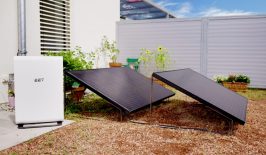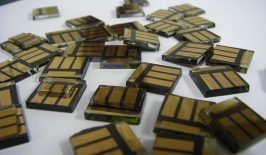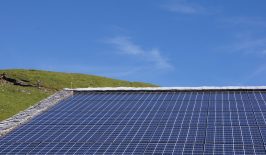An Australian University has claimed a breakthrough in the development of wafer thin, cheap solar panels. The University of Newcastle Centre of Organic Electronics in Callaghan, New South Wales has created printable photovoltaic solar cells which, it has been claimed, could revolutionise urban power generation.
The panels, which are only 0.075 millimetres thick, were created with proprietary technology making use of organic polymers which can capture solar energy and conduct electricity. Traditional photovoltaic solar panels rely on silicon to carry out these functions and can often weigh up to 15 kilograms per square metre. What’s more, the liquid nature of the organic polymer means it can be printed from printers much like those used to mass produce newspapers and books.
According to University of Newcastle physics professor Paul Dastoor, printed solar technology could be used to fit into a number of broad applications, such as power for street lights, water pumps, disaster shelters, camping equipment, building smart blinds for buildings and even powering vehicles. Another application, missing from media reports but present on the project’s website, is the potential military utility of such technology.
The cost of production is also much cheaper than traditional panels, coming in at around 10 AUD per square metre. The University’s Institute for Energy and Resources (NIER) can produce hundreds of metres of material daily, but it is hoped a full scale commercial plant could print kilometres of solar panels a day. The printed sheets can also be stuck, with a special adhesive tape, to a variety of surfaces, meaning no expensive and intrusive installation methods.
The technology is currently on public display at the ‘The Canopy‘, a new community precinct built in Lane Cove on Sydney’s north shore. The panels, which are attached to a covered walkway, generate power for a series of lights that come on at night and track passersby with sensors.
Will We See Solar Panel Pollution?
The cheap cost, lightweight material and production methods do come with some disadvantages, however. Most notably, the printed solar panels only work at a fraction of the efficiency of larger, more expensive models. Currently, they can only produce around two percent of a comparably sized traditional panel, meaning they can likely only be used for ultra-low-power applications, such as the sensors or intermittent lighting featured on their public display.
Furthermore, printed solar cells are much less durable and have a lifespan of only two years, compared to around 20 years for their larger, more expensive cousins. Professor Dastoor states that to become competitive, the printed solar panels would need to last at least three years and consistently deliver around 3 percent efficiency.
The short lifespan also means the printed solar cells might be purchased in a different way than normal rooftop panels. Professor Dastoor envisions a system in which space, whether on a roof or elsewhere, is leased out to a provider. The relationship would then work similar to a mobile phone contract, with the electricity provider installing and replacing the panels with newer models as they wear out. In exchange for signing up to the contract, the consumer can then enjoy cheaper electricity than their current bill.
There is, however, one more significant issue. Currently 99 percent of the printed solar panels consist of PET, a plastic material that contributes significantly to waste pollution. If kilometres of the material were to be produced daily, it could result in vast amounts of waste in a relatively short time span. Although cheaper solar power will likely boost its adoption, creating cheaper but more disposable solar panels on a large industrial scale could actually contribute to environmental damage. Luckily, the team is aware of this issue and are currently investigating methods to remove the outer PET layer and recycle it into new panels.






